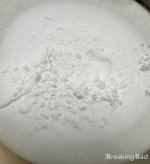- Joined
- Mar 15, 2022
- Messages
- 645
- Solutions
- 1
- Reaction score
- 673
- Points
- 93
- Deals
- 8
Hello,
After many tests using Methylamine HCL based on this method I will share the best way that I found to obtain Methamphetamine freebase in big scale:
- Fill the reactor with the 14 L of Methanol
- With stirring dissolve the Methylamine HCL
- Put the reactor temp at 0C(not the mixture temp) and add the NaOH, the temp will increase
- Once the temp come back to 20C add the P2P, the temp will increase stir it during 45min-1 hour
- Add 252gr of anhydrous sodium sulfate
- When the mixture temp arrives to 8C start adding portionwise the NaBH4 not exceeding the 20C
- Once all the NaBH4 has been added let it mixing under 20C during aprox 2 hours until the mixture stops bubbling
- Add the water and continue mixing during 5 min
- Add the DCM and mix it during 10 min
- Stop stirring and let layers get separated
- Keep the bottom layer and discard the upper one( not profitable to extract this aqueous phase)
- Add 200gr of anhydrous sodium sulfate to the saved layer and mix it
- Filter it in Buchner Funnel
- Evaporate the DCM
- Clean and smelly Methamphetamine freebase obtained
;-)
After many tests using Methylamine HCL based on this method I will share the best way that I found to obtain Methamphetamine freebase in big scale:
- 966 gr P2P
- 14 liters Methanol
- 1183 gr Methylamine HCL
- 638gr NaOH
- 452 gr Anhydrous Sodium Sulfate
- 105 gr NaBH4
- 35 L distilled water
- 7 Liters DCM
- Fill the reactor with the 14 L of Methanol
- With stirring dissolve the Methylamine HCL
- Put the reactor temp at 0C(not the mixture temp) and add the NaOH, the temp will increase
- Once the temp come back to 20C add the P2P, the temp will increase stir it during 45min-1 hour
- Add 252gr of anhydrous sodium sulfate
- When the mixture temp arrives to 8C start adding portionwise the NaBH4 not exceeding the 20C
- Once all the NaBH4 has been added let it mixing under 20C during aprox 2 hours until the mixture stops bubbling
- Add the water and continue mixing during 5 min
- Add the DCM and mix it during 10 min
- Stop stirring and let layers get separated
- Keep the bottom layer and discard the upper one( not profitable to extract this aqueous phase)
- Add 200gr of anhydrous sodium sulfate to the saved layer and mix it
- Filter it in Buchner Funnel
- Evaporate the DCM
- Clean and smelly Methamphetamine freebase obtained
;-)
↑View previous replies…
- Joined
- Feb 22, 2023
- Messages
- 14
- Reaction score
- 6
- Points
- 3
- By Doubleboil
-
11 Mar
and @G.Patton
Can I get some help please. I can’t get it to crystallise. Here’s what I’ve done more then a couple times.
methylamine hcl dissolved in Meoh
Naoh added and salt appears.
p2p added temp up and back down.
nabh4 on ice.
mgso4 normal
Water added and turns kinda foamy like milk
Dcm added
Separate take dcm layer. Color yellowish
MgSO4 and filter
Now this dcm layer has many small bubbles inside. (Air and product)?
Dcm is evaporated leaving a light golden oil.
Ph adjusted to 7 ( I’ve tried with ph 6 and 5 also)
Acetone added by
-3 to 1 ratio and freezer
-3 to 1 ratio air dry
-1 to 1 ratio and freezer
-1 to 1 ratio air dry
All of them failed. No crystals. Any insight would be appreciated. Thanks!
Can I get some help please. I can’t get it to crystallise. Here’s what I’ve done more then a couple times.
methylamine hcl dissolved in Meoh
Naoh added and salt appears.
p2p added temp up and back down.
nabh4 on ice.
mgso4 normal
Water added and turns kinda foamy like milk
Dcm added
Separate take dcm layer. Color yellowish
MgSO4 and filter
Now this dcm layer has many small bubbles inside. (Air and product)?
Dcm is evaporated leaving a light golden oil.
Ph adjusted to 7 ( I’ve tried with ph 6 and 5 also)
Acetone added by
-3 to 1 ratio and freezer
-3 to 1 ratio air dry
-1 to 1 ratio and freezer
-1 to 1 ratio air dry
All of them failed. No crystals. Any insight would be appreciated. Thanks!

